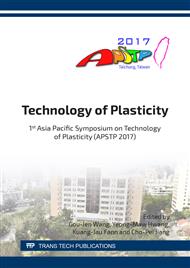p.108
p.114
p.120
p.126
p.132
p.141
p.149
p.155
p.161
The Numerical Simulation and Experiment Verification of the Large Aluminum Alloy Covering Part of Car Using Sequential Coupling Technology
Abstract:
Based on the large aluminum alloy covering part of car with characteristics such as complex shape and structure and the requirements of surface quality, in this paper, the covering part is formed by use of the combination of liquid medium forming with high pressure and local shaping with rigid mold which is also named as sequential coupling forming technology. It was analyzed from the aspect of the numerical simulation and experimental verification respectively. Firstly, the numerical simulation of the liquid medium forming with high pressure of the part was carried out using the special sheet forming software DYNAFORM, according to the results of numerical simulation, the key parameter such as loading path of liquid chamber pressure was optimized and the hydraulic test was carried out according to the optimal results. As a result, the parts with good surface quality were obtained. Then, in order to fully form the small features in the part which are difficult to form, reduce the equipment tonnage, and the dimensional accuracy of parts which have been formed were not affected, the method using a rigid mold to shape the local parts in the part was adopted, and the final part with good quality was obtained according to the experiment. Taking the final part as the study object, the experimental values and numerical simulation values of the wall thickness along the typical paths were measured and compared respectively. According to the comparison results of the wall thickness, the numerical simulation values have a good agreement with the experimental results, and the sequential coupling forming technology using the combination of liquid medium forming with high pressure and local shaping with rigid mold is verified feasible.
Info:
Periodical:
Pages:
132-140
Citation:
Online since:
April 2018
Authors:
Keywords:
Price:
Сopyright:
© 2018 Trans Tech Publications Ltd. All Rights Reserved
Share:
Citation:


